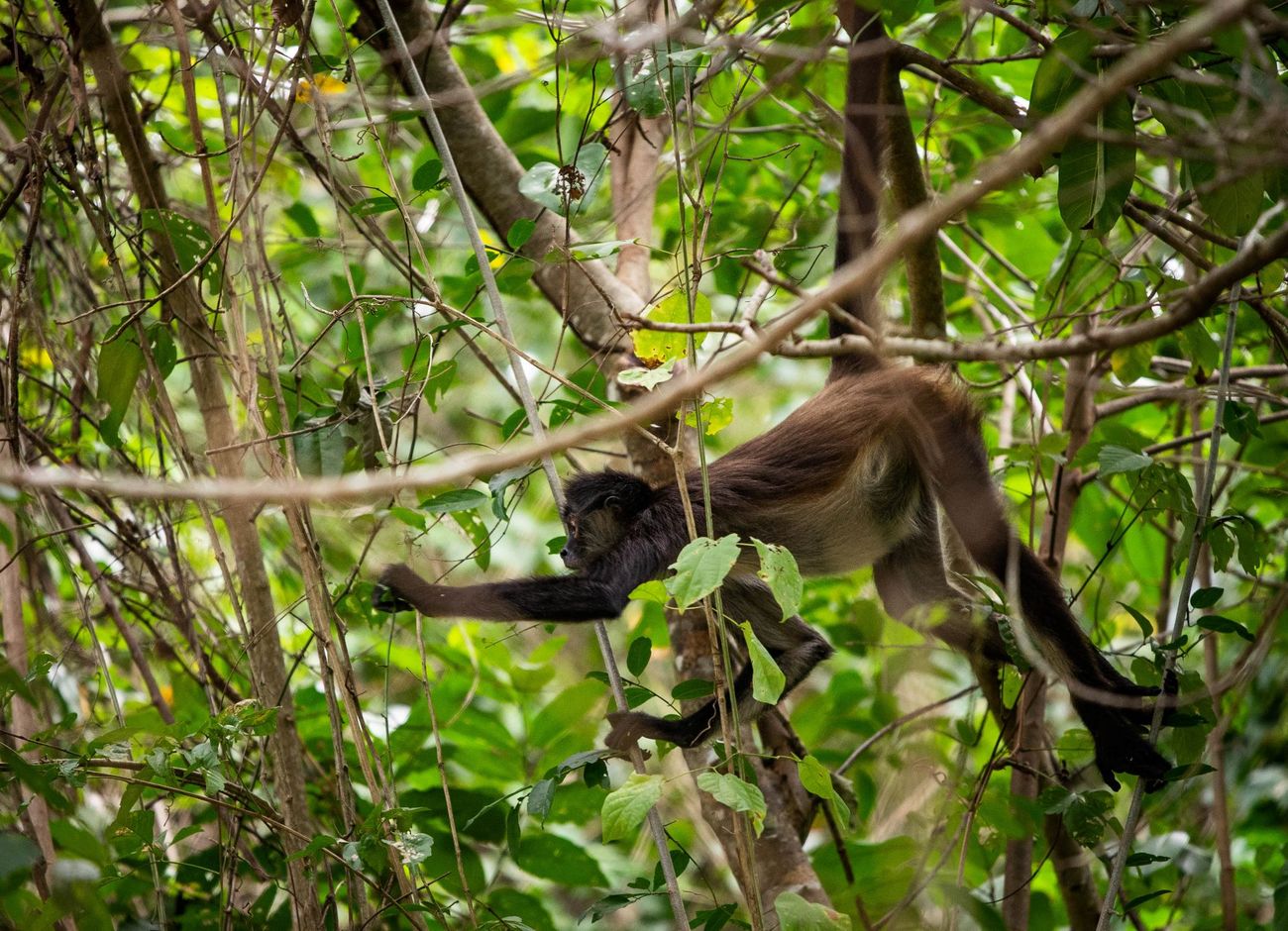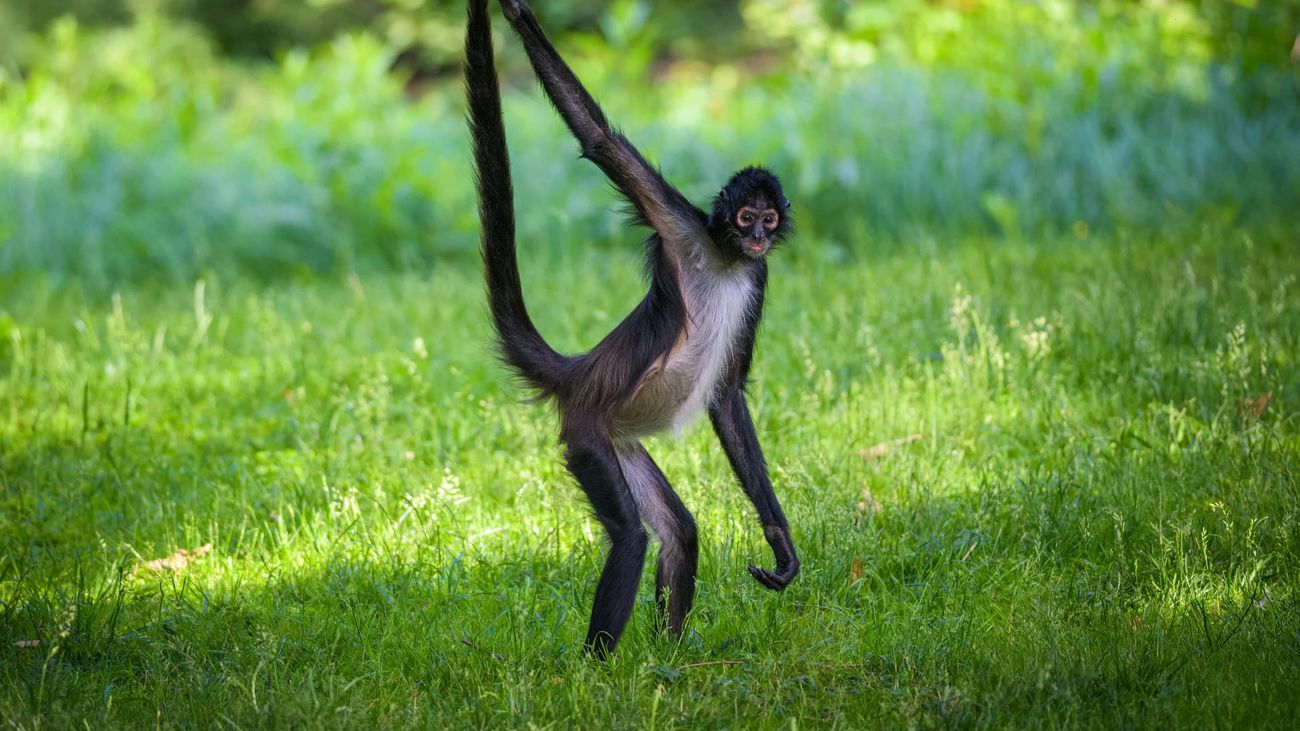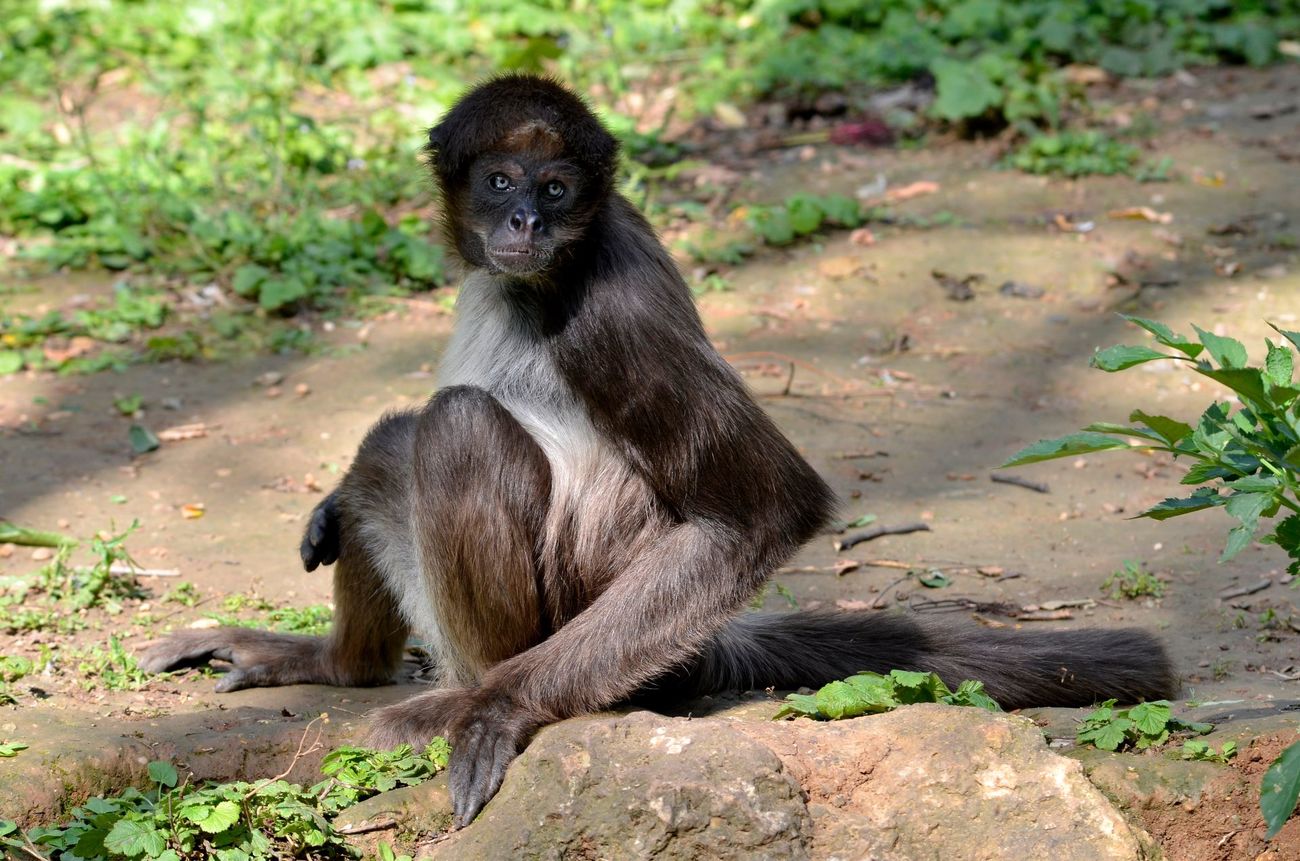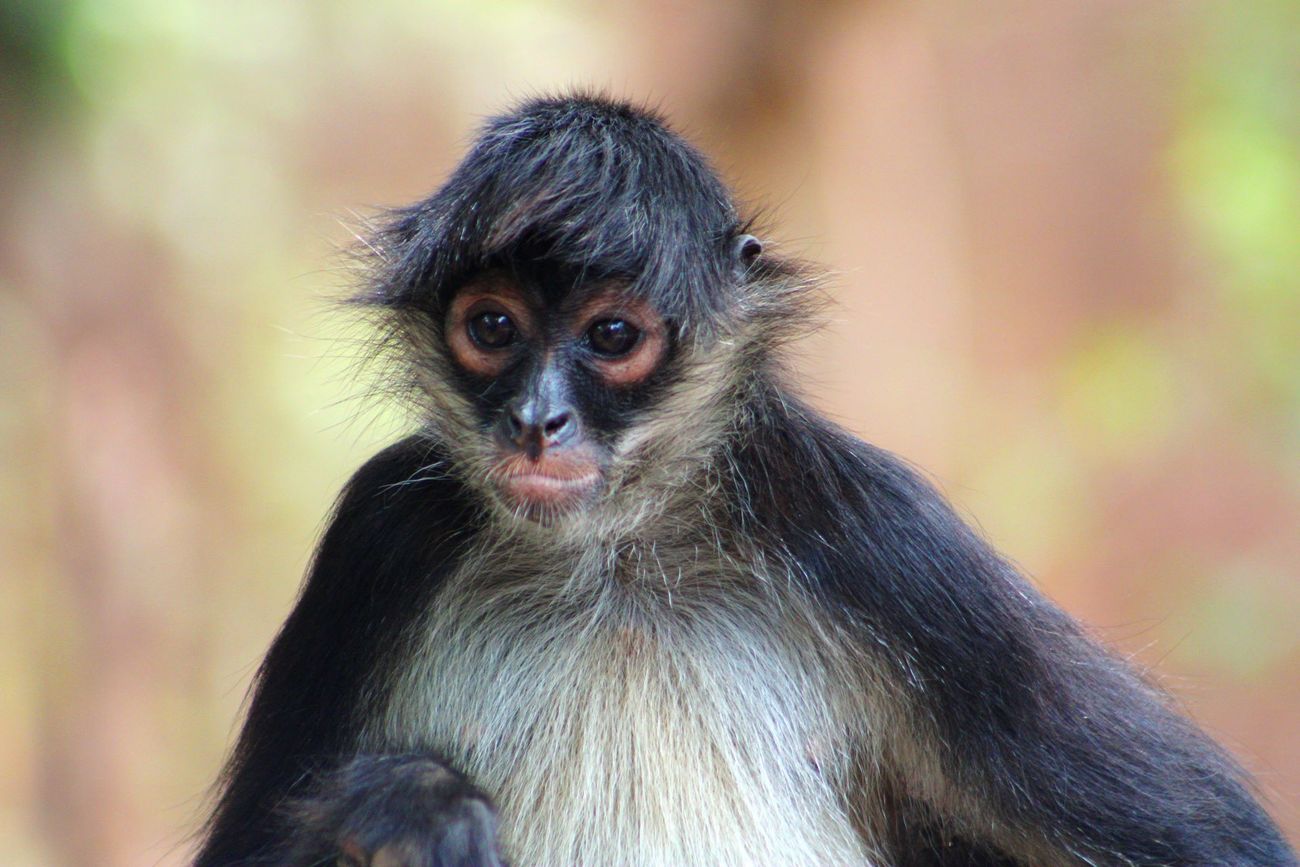Spider monkeys
Spider monkeys belong to the Ateles genus and are characterised by their long arms and hook-like hands. On average, they weigh about six kilograms (13.25 pounds) and have a body length of 35 to 66 centimetres (14 to 26 inches).
They also have long tails that can grow to lengths of 88 centimetres (35 inches). These tails are prehensile, which means they’re often used as a fifth limb for grasping. All of these physical traits contribute to spider monkeys being extremely agile and adept at swinging from tree to tree, allowing them to thrive in an arboreal (tree-based) lifestyle.
There are seven recognised species of spider monkeys, each displaying specific colour patterns and physical distinctions. This kind of diversity ensures a wide range of adaptations and characteristics within the broader spider monkey classification.
The genus name Ateles translates to ‘imperfect’ in Greek. This is a reference to the spider monkeys’ lack of opposable thumbs—a notable difference from some other primate species. It’s important to note that this does not hinder their ability to thrive in their natural habitats in any way.
Spider monkeys primarily live in large groups known as troops. These troops can consist of anywhere from 20 to 100 individual monkeys and often further divide into smaller groups when it comes to feeding and foraging. Being diurnal creatures, spider monkeys are most active during daylight hours, and their arboreal nature means they predominantly stay in the treetops.
Communication between spider monkeys is very complex. They employ a combination of vocal calls, facial expressions, and body postures to convey messages and emotions to one another. Their varied communication is also evidenced by their intricate social structure. Spider monkeys engage in polygamous mating patterns and form typically short-lived, temporary pairings known as consortships.
In terms of food, spider monkeys primarily sustain themselves on a diet rich in fruits. However, they also eat flowers, bark, seeds, leaves, and even insects. In times of limited food availability, spider monkeys will deviate from their normal diet even further, eating bird eggs, small animals, and honey.
Beyond their personal sustenance, spider monkeys’ eating habits also play a significant ecological role. As they forage, they inadvertently aid in shaping the composition of their forest habitats, primarily through seed dispersal.
As they move about the canopy, dispersing seeds through their droppings, they actively assist in the regeneration and health of their habitats. This seed dispersal is fundamental in maintaining the diversity and vitality of tropical forests and helps to ensure the continued propagation of tree species within their habitats.
Spider monkeys also have long lives in their natural habitats, typically around 22 years. They have distinct reproductive patterns, and their gestation period lasts approximately seven to seven and a half months. Female spider monkeys will generally produce one offspring each year or one every two years.
Baby spider monkeys are born fully furred and spend the first 16 weeks of their lives on their mothers’ stomachs before transitioning to riding on their mothers’ backs. They mature quickly, with reproductive maturity reached by females at around the age of four. Males tend to mature slightly later, at approximately five years of age.
The bond between mother and young is particularly strong in spider monkeys. This close relationship ensures the young receive adequate care and protection, often resulting in the juveniles remaining in close proximity to their mothers for several years before becoming independent.
What is a spider monkey’s scientific name?
Spider monkeys are part of the family Atelidae. This family includes some of the largest New World monkeys. ‘Spider monkey’ actually refers to about seven different species of monkeys that all share similar looks and behaviours.
Each species has its own unique traits, but they all belong to the broader Ateles or spider monkey category. Here’s a quick rundown of the different types:
- Brown-headed spider monkey: Ateles fusciceps
- Red-faced spider monkey: Ateles paniscus
- Peruvian spider monkey: Ateles chamek
- White-cheeked spider monkey: Ateles marginatus
- White-bellied spider monkey: Ateles belzebuth
- Geoffroy's spider monkey: Ateles geoffroyi
- Brown spider monkey: Ateles hybridus
There is also another species of monkey called the woolly spider monkey or muriqui. Despite their name, these monkeys are not spider monkeys. They are a different type of monkey with a different genus.
Are spider monkeys endangered?
Sadly, all true spider monkeys are endangered. This means they’re at high risk of disappearing from the wild. Two species—the brown-headed and brown spider monkeys—are critically endangered, which means they are on the brink of extinction.
Where do spider monkeys live?
Spider monkeys predominantly live in tropical rainforests of Central and South America, stretching from Mexico to Bolivia. They thrive high up in the forest canopy, but their adaptability extends beyond just rainforests, and they are also found in semi-deciduous forests and mangroves.
Threats
Unfortunately, there are a number of threats that spider monkeys face today, including poaching, habitat loss, and the pet trade. These threats contribute to their endangered status.

Poaching
One of the most pressing threats faced by spider monkeys is poaching. This illegal hunting activity has deeply scarred their populations, particularly in regions where consuming their meat is ingrained within local customs. In places like Ecuador, hunting spider monkeys for bushmeat—illegal trade in animal meat—has a historical context. Despite it now being outlawed, this makes enforcement of anti-poaching laws challenging.
A significant factor that exacerbates this problem is the spider monkey’s natural characteristics and behaviours. Due to their relatively large size compared to other primates, they are perceived as a valuable catch, providing substantial meat from a single hunt. This makes them a prime target for those seeking bushmeat for food or sale.
Spider monkeys are also captured and used for medicinal purposes and clinical trials, pushing them closer to the brink of endangerment or even potential extinction if stringent measures are not taken.
Their social behaviours can also make them more susceptible to poaching, with large troop sizes making spider monkeys easy to locate. Additionally, although they are very nimble in the treetops, they are relatively slow on the ground, making them an easy target for hunters.
Habitat loss
Another critical threat to spider monkeys is the rapid and widespread loss of their natural habitats. The forests they call home are disappearing at an alarming rate, primarily due to human-driven activities.
One of the major culprits behind this habitat destruction is deforestation, often fueled by the logging industry. Trees—many of which have stood for centuries—are felled to cater to the global demand for timber. Beyond logging, there’s the growing need for agricultural land. As human populations rise and the demand for food escalates, forests are being replaced by farmlands.
Slash-and-burn farming—the removal of trees and vegetation followed by burning of the land to prepare it for agriculture—also continues to be practised. Livestock ranching causes similar problems. This is a huge industry in many parts of Central and South America that requires vast expanses of land, leading to more forest areas being cleared.
The ramifications of this habitat loss on spider monkeys are dire. Spider monkeys thrive in continuous forests where they can maintain large social groups and find food efficiently. They are heavily reliant on vast, unbroken stretches of forest for their survival. When these habitats become fragmented, their survival tactics are hampered. This makes them more susceptible to both poachers and predators and further reduces their chances of reproduction.
Pet trade
The exotic pet trade is a huge threat to spider monkey populations. Driving this demand is the unfortunate appeal of young spider monkeys as pets. While some might be enamoured by the idea of having a spider monkey as a pet, the reality behind this trade is far bleaker than many realise.
Being captured, separated from their mother, and placed in a cage is an extremely distressing ordeal for a young spider monkey. Experiencing this at such an early age can inflict deep psychological scars. It alters their behaviour and can drastically reduce their chances of survival even if they are returned to the wild.
The method of capture further magnifies the threat they face. To easily snatch a young spider monkey, poachers often resort to killing the mother. This not only results in the tragic death of an adult monkey but also leaves the infant traumatised and without maternal guidance. These practices deal dual blows to the spider monkey populations, reducing the number of breeding adults and removing the next generation from their natural habitat.
The implications of the pet trade for spider monkeys are wide-ranging. In addition to the concerns about individual monkeys being uprooted from their natural habitats, the pet trade threatens the survival and continuity of spider monkey species.
FAQs
What do spider monkeys eat?
The spider monkey diet is quite varied. Their diet primarily consists of fruit, but they also eat leaves, nuts, and seeds, as well as spiders and insects. In times when food is hard to find, they eat bird eggs, small animals, and honey.
How many spider monkeys are left in the world?
The exact number of spider monkeys left in the wild varies by species. It’s difficult to determine due to their wide distribution and how elusive they can be in their dense rainforest habitats. The brown-headed and brown spider monkey species are both very low in population numbers. The brown spider monkey is classed as critically endangered.
How much does a spider monkey weigh?
A spider monkey typically weighs about six kilograms (13.25 pounds). Female spider monkeys usually weigh a little less than males. Their light bodies make it easier for them to swing from tree to tree, a behaviour called brachiating.

How big are spider monkeys?
Spider monkeys can grow quite large, with their bodies measuring 35 to 66 centimetres (14 to 26 inches). They also have extremely long tails that can reach lengths of 88 centimetres (35 inches).
Why are spider monkeys endangered?
Spider monkeys are endangered because of hunting, habitat loss, and the illegal pet trade. People cut down forests for wood, farming, and raising animals, destroying the monkeys’ homes. Spider monkeys need large, uninterrupted forests to thrive. They also have a relatively long reproductive cycle, making it hard for their numbers to bounce back.
How long do spider monkeys live?
In the wild, spider monkeys usually live to about 22 years old. But in captivity, where they’re protected from dangers and sickness, they can live for up to 40 years. Since female monkeys only have offspring every one to two years, threats to their survival can hit their populations hard.

Are spider monkeys good pets?
Spider monkeys do not make good pets. In fact, in many places, it’s illegal to have one as a pet. They have complex needs that can’t be met in a human home—they need to eat a specific diet, socialise and live with other monkeys, and make their homes high up in trees. They’re also wild animals and can become aggressive as they get older, potentially putting themselves and others at risk. The pet trade is also a contributing factor to spider monkeys being endangered.
Are spider monkeys dangerous?
Spider monkeys are usually not dangerous to people, but if they feel threatened, they might defend themselves. Adult monkeys—especially males—can be strong and might bite if they’re upset or stressed. In the wild, they can also spread diseases to people, although this is quite rare.
How can you help?
Spider monkeys are threatened by poaching, habitat loss, and the illegal pet trade. All spider monkey species are endangered.
